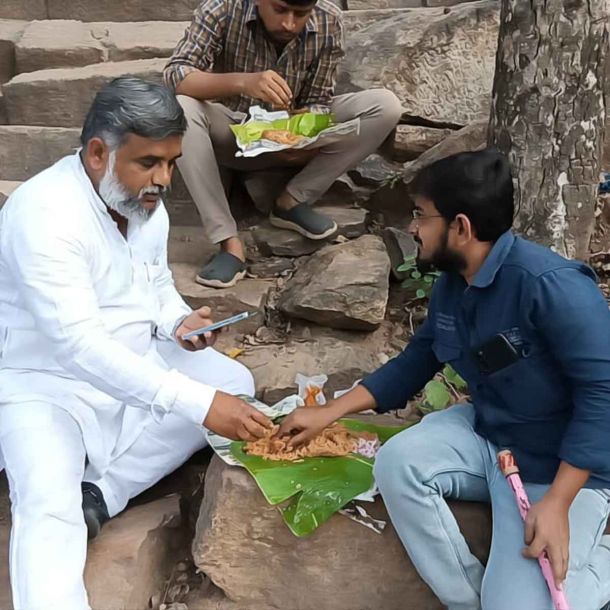More Coverage
Twitter Coverage
Satyaagrah
Written on
Satyaagrah
Written on
Satyaagrah
Written on
Satyaagrah
Written on
Satyaagrah
Written on
Join Satyaagrah Social Media
Gita Press Gorakhpur – Bringing Sacred Hindu Texts to Every Hindu Home

Which Hindu wouldn’t have heard the name of Gita Press Gorakhpur? Which Hindu household wouldn’t have at least one publication from it – Gita, Mahabharata, Upanishadas, or at least the Hanuman Chalisa booklet – from over 2,000 sacred granthas published by it in over 20 languages? 'Gita Press' - This name in itself is its complete introduction. This institution is the very image of the divine resolve which worked as the motivating force for its establishment.
Gita Press was established in 1923 A.D. by JD Goyanka in order to serve humanity for truth, love and peace.
Hanuman Prasad Poddar was the founding editor of Gita Press. It is a unit of the Gobind Bhawan Karyalaya, Kolkata, registered under the Societies Registration Act, 1860, (presently governed by the West Bengal Societies Act, 1960). Since 1923 it has been propagating and promoting morality and spirituality through its literature throughout the world.
The institution’s main objective is to promote and spread the principles of Sanatana Dharma, the Hindu religion among the general public by publishing Gita, Ramayana, Upanishads, Puranas, Discourses of eminent Saints and other character-building books & magazines and marketing them at highly subsidized prices.
The institution strives for the betterment of life and the well-being of all. It aims to promote the art of living as propounded in the Gita for peace & happiness and the ultimate upliftment of mankind. The founder, Brahmalina Shri Jayadayalji Goyandka, was a staunch devotee and an exalted soul. He was much given to the Gita as the panacea for mankind’s plight and began publishing it and other Hindu scriptures to spread good intent and good thought amongst all.
In the last 98 years of its existence, the institution has made available more than 68 crore 28 lakhs (Till 31 March 2019) copies of the Gita, Ramayan, Bhagvat, Durga Saptashati, Puranas, Upanishads, Bhakta-Gathas, and other character-building books in Sanskrit, Hindi, English, Nepali, Gujarati, Tamil, Marathi, Bangla, Oriya, Telugu, Kannada, Malyalam, Assamiya, Urdu, Punjabi – all at a very small price (the basic Gita is for Rs 7) with the highest standard quality of paper and printing.
While other Hindi journals of colonial India—whether religious, literary or political—survive only in the archives, to be read by scholars interested in unravelling the heady days of Hindi and Hindu nationalism, Gita Press, with its flagship monthly Kalyan, has grown and prospered as the only indigenous publishing enterprise of the period that continues to this day. With around 70 retail outlets across India, including stalls at many railway stations, Gita Press is a stupendous success in the world of Indian publishing.
Origin of Geeta Press
The origin of the idea for Gita Press is in a prison cell of British Bharat at the turn of the last century. Hanuman Prasad Poddar was a young son of a Marwari business family in Kolkata. He was drawn to the activities of Anushilan Samiti revolutionaries – with the likes of Aurobindo Ghosh.
This young Marwari, Hanuman Prasad Poddar, used his family’s godowns and network to help the revolutionaries procure and store arms. As a result, he was arrested, tried and imprisoned in Alipore prison (where Aurobindo Ghosh also was kept.) That is where he started studying Gita.
He was eventually released but his love for Bhagavad Gita continued. He eventually came in contact with Bal Gangadhar Tilak and was very influenced by Tilak’s take on Gita. He also studied other commentaries & translations and started to write about Gita himself.
It may be difficult to imagine today but there was a time when a good copy of Gita was not so easy or handy to find. Poddar was very sorry to see this. On the other hand, Calcutta being the capital of missionary activity, Poddar used to see Bibles distributed everywhere.
Poddar decided that he would edit, finance, and mass print thousands of copies of Bhagavad Gita – on as good quality paper as possible and distribute these at an extremely small price – the smallest coin of 1 paisa. This was in mid of 1910s.
He was joined in the enterprise by Jaydayal Goenka, a fellow Gita enthusiast and an older close relative, also a more resourceful businessman as well as one who was better versed in shastras and an eloquent speaker.
The first printing project was however a disaster. Both the young fellows were disappointed that the first batch of Gitas, despite very careful proofreading by Poddar, had a large number of spelling mistakes. The copies had to be destroyed.
They, then, chose another printing press and yet, to their utter disappointment, there were still many mistakes. But Poddar would not accept a single error. When Poddar insisted on a reprint, the printing press owner said, half in jest, print it yourselves. Poddar liked the idea!
His older cousin Jaydayal Goenka had some estate in Gorakhpur. They decided to establish their own printing press “Gita Press”, at Gorakhpur with Poddar to oversee editing and proof reading himself along with Hindi translation. Thus in the year 1923, Gita Press came into existence. It was inaugurated by Dr. Rajendra Prasad.
Poddar engaged scholars of Tamil, Telugu, Kannada, Bangla, Marathi and Gujarati for simultaneous translations as well as Pandits for starting the work on the other granthas, especially Mahabharata, Ramayana and the Puranas. He also hired artists from all over Bharat for religious art. Here are some artworks of Gita Press artists from 1930s and 1940s –
There were the likes of Venkateshwara Press and Anand Ashram that were already printing texts since the last few decades and Ravi Varma had already established a lithograph press. But the key for Poddar was that every Hindu throughout Bharat should be able to ACCESS and AFFORD them.
Kalyan Magazine
One of those days, although according to some it was the idea of Ghanshyam Das Birla, the thought of publishing a monthly magazine focusing on Hindu matters occurred to the cousins Goenka and Poddar. Under Poddar’s editorship, the first issue of ‘Kalyan‘ (कल्याण) was published in 1926.
Kalyan magazine, today subscribed by over half a million households, carried no advertisements ever.
While Gita Press was and is not for profit, thanks to the business acumen that came naturally to the two Marwari cousins, coupled with Dharma at heart, within the first 5 years in operation, Gita Press spread out into a successful large catalogue and a vast distribution network.
By 1930s, Poddar had expanded the coverage to both the itihasas, all the Puranas, the main Upanishadas, important Sutra literature like yogasutra and brahmasutra, key bhashyas by the teachers along with their translations in Hindi and 8 other languages and posters like these.
Now Poddar started on Bhakti Literature like Tulsidas’ Ram Charit Manas and Vinay Patrika, Surdas’ Soor Sagar and others. His vision was beyond Hindi. Tamil texts like Kamban’s Ramayana, Andal’s Thiruppavai, Telugu text like Potanabhagavatamu, etc. were also considered by him.
Gita Press in Gorakhpur became a place where scholars from across Bharat – speaking, writing, translating in many languages – mixed and cross-pollinated. The Gita Press entrance was designed to look like a miniaturized mixture of the Meenakshi temple and the Kashi Vishwanath temple.
Now unlike many others, Poddar and Gita Press were not blind from this-worldly challenges of Hindus. In mid 1930s-40s, Poddar was very vocal in condemning the policies of Indian National Congress. While earlier he was a Gandhian himself, now he wrote to Gandhi challenging his interpretation of Gita.
Poddar was in communication with Savarkar as well. When Savarkar returned from Andaman, Poddar went to Mumbai and met him. Gita Press actively promoted Gauraksha and removal of untouchability.
Few people know about the collaboration of Gita Press and the Gorakh Matha. Presiding head of the Matha is also “sanrakshaka” (protector) of the Press and honorary head (currently Yogi Adityanath is the Sanrakshaka).
Gita Press also has a very rich archive to preserve some more than 6,000 manuscripts of different granthas in many languages. It also curates a museum of religious art works from across Bharat, running into many hundreds.
The great service done by Hanuman Prasad Poddar and Jaydayal Goenka to make available various Hindu texts at affordable price to the public had, in a way, played a significant role in bringing Hindus together. It won’t be wrong to say that even today, every Hindu home has some or the other book that has been printed at the Gita Press Gorakhpur.
Gita Press had both the sanction of Indian nationalists, and a deep reach, through Kalyan, into middle-class homes. Nowhere else could you get articles by Mohandas Gandhi, presidents S Radhakrishnan and Rajendra Prasad, the Swatantra Party founder C Rajagopalachari and the Congress party leader Govind Ballabh Pant—as well as Hindutva stalwarts such as the RSS head MS Golwalkar, the Ram Rajya Parishad founder Swami Karpatri Maharaj, and the spiritual leader Prabhudatt Brahmachari—all in one special issue. Considering its significance, the near-total lack of critical evaluation of Gita Press by its contemporaries is surprising; instead, it has been relegated to an odd paragraph, appendix or footnote. Little has been written about how Hindu nationalists used Kalyan’s novelty and reach among the Hindu reading public, with Gita Press and its iconic founding editor, Hanuman Prasad Poddar, as willing partners.
Poddar was more concerned with spirituality than politics; at times, he even felt the business of running a press frustrated his spiritual aims. However, in the years preceding the independence of India, disillusioned with what he called the anti-Hindu policies of the first Congress government, Poddar made a clear choice to openly support, even get actively involved in, the politics and struggles of Hindu nationalist groups and, later, political parties such as the Jana Sangh. When Hindu nationalist groups began what the political scientist Christophe Jaffrelot described as “using ethno-religious appeals to build up agitational movements,” Kalyan became a propaganda vehicle to disseminate their worldviews. The increasingly polarised position of the Gita Press, and its growing importance to the Hindu nationalist cause, can be traced through several such agitational movements, including the opposition to the Hindu Code Bill and other social reforms that sought to reconcile Hindu practices with the rights to equality guaranteed by the nascent constitution of the Indian state.
@nehaltyagi08
@KrutadnyaM
@PunyaPrakop_
@desi_thug1
|
Website: https://www.gitapress.org
 Support Us
Support Us
Satyagraha was born from the heart of our land, with an undying aim to unveil the true essence of Bharat. It seeks to illuminate the hidden tales of our valiant freedom fighters and the rich chronicles that haven't yet sung their complete melody in the mainstream.
While platforms like NDTV and 'The Wire' effortlessly garner funds under the banner of safeguarding democracy, we at Satyagraha walk a different path. Our strength and resonance come from you. In this journey to weave a stronger Bharat, every little contribution amplifies our voice. Let's come together, contribute as you can, and champion the true spirit of our nation.
 |  |  |
| ICICI Bank of Satyaagrah | Razorpay Bank of Satyaagrah | PayPal Bank of Satyaagrah - For International Payments |
If all above doesn't work, then try the LINK below:
Please share the article on other platforms
DISCLAIMER: The author is solely responsible for the views expressed in this article. The author carries the responsibility for citing and/or licensing of images utilized within the text. The website also frequently uses non-commercial images for representational purposes only in line with the article. We are not responsible for the authenticity of such images. If some images have a copyright issue, we request the person/entity to contact us at satyaagrahindia@gmail.com and we will take the necessary actions to resolve the issue.
Related Articles
- Dear NSUI, Bhagat Singh And Subhas Chandra Bose Admired Savarkar And His Ideas
- Jagannath Temple administration issues clarification on proposed sale of temple lands
- The forgotten temple village of Bharat: Maluti
- The Forgotten Story of Rani Abbakka Chowta, the Fearless Warrior Queen of Tulu Nadu
- Surat residents play Hanuman Chalisa twice a day from temples, rooftops to get close to Dharma: The pushback begins
- The Untold Story of the Brave Maratha Warrior Queen Ahilyabai Holkar!
- अथ रामचरितमानस प्रकाशन कथा: गीता प्रेस, गोरखपुर ने 1938 से रामचरितमानस का प्रकाशन शुरू किया
- Biggest Wonder of the World : Kitchen of Lord Shri Jagannath
- Culture And Heritage - Meenakshi Temple Madurai
- Lakshmi Narasimha Swamy Temple, Antarvedi, Andhra Pradesh
- An Artisan Heritage Crafts Village: Indigenous Sustainability of Raghurajpur
- Srikalahasti Temple, Dakshina Kailash
- Why Hindus not claiming their temples back from the Government control: Is pro-Hindu govt will always be in power
- Shri Murudeshwar Temple: Home To The World’s Second Tallest Shiva Statue
- Birsa Munda: The tribal folk hero who was God to his people by the age of 25

























